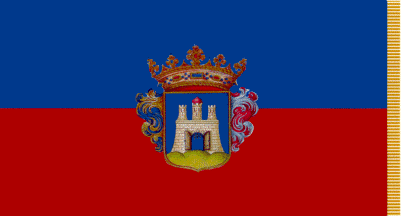
image by István Molnár, 9 February 2001

Last modified: 2025-01-18 by zoltán horváth
Keywords: hungary | fejer | szekesfehervar |
Links: FOTW homepage |
search |
disclaimer and copyright |
write us |
mirrors

image
by István Molnár, 9 February 2001
See also:
From:
http://www.konkoly.hu/staff/budavari/Szfvar.html :
the city of the kings ', was the first capital of Hungary. Its
name is Alba Regia in Latin. Now it is the seat of Fejér county,
its population is 130,000 and it is a road and railway junction.
The downtown is rich in historical monuments and museums.
Dov Gutterman, 2 August 1999
Székesfehérvár is a city in Fejér County in Hungary near
to the Lake of Velence (10 km West). The city has got 107.073
inhabitants (1990 census), nearly all of them are Hungarians.
Five of the Official Ethnic Minorities of Hungary has got ethnic
council in the city. Gipsy, Polish, German, Armenian and Serb.
Neighbouring settlements are: Zámoly, Sárkeresztes, Moha,
Iszkaszentgyörgy, Csór, Sárszentmihály, Szabadbattyán, Tác,
Aba, Seregélyes, Pákozd and Pátka villages. The name of the
city: Székes means Royal and Fehérvár means White Castle. The
German name is a wrong translation: Stuhlweissenburg. Stuhl in
Hungarian Szék (means chair) The Latin name of the city in the
Middle Ages was Alba Regalis (means Royal White Castle).
From http://www.szekesfehervar.hu/drszfveng/history.htm/:
"Székesfehérvár, named Alba Regia in the middle ages, is
one of our most ancientcities. The significant events of our
history happened here through the centuries. This was the place
where our kings were crowned and buried. The king's throne and
the symbols of the royal power were kept here (...) Géza the
great emperor established Székesfehérvár as a emperor abode
during his principality (972 - 997) on the hills surrounded by
swamps. He built an abode surrounded by ditches and a mound. It
was a Byzantine-style quatrefoil church, one of the first
Hungarian stone built churches, which later served as his
resting-place. The ground plan of the church is marked by the
different coloured paving stones on the square in front of the
cathedral. The name Alba Civitas first appeared in the bishopric
diploma of Veszprém in 1009. Under King Saint Stephen's rule
(1001 -1038) it was a populous and extended settlement, which was
surrounded by palings and walls built of soil. King Stephen's
basilica was one of the monumental buildings of its time in
Europe; it was quite a technical miracle. The basilica was the
most significant place of the mediaeval Hungarian State
throughout five centuries. There, in the cathedral stood the
throne, was kept the crown, the symbols of the royal power, the
country's treasury, and archives. It was the scene of forty-six
diets (...) the royal coronations and funerals were still held in
Alba Regia even after the Árpád dynasty had died out (1301).
The Turks occupied the strategically important city in 1543 and
kept it under their rule for 145 years. During the days of
Turkish rule the pompous buildings of Istolni Belgrád - Turkish
name of Alba Regia - were rebuilt into dzsámis, and mosques, and
the graves of the royal basilica were completely despoiled. (...)
The rule of the Turkish crescent ceased in 1688. At the same time
when renovating and rebuilding works were still in process the
city had to carry on a fight against the Austrians to get back
our privileges and rights. The imperial commissioner wielded the
actual power over Székesfehérvár until 1703 when the
city gained back its past rank: it was a free royal
city again."
From http://www.fejer.hu/tortenelem2.html/:
In 1910 Székesfehérvár was a city in the Kingdom of Hungary.
Number of its inhabitants in 1910: 36.625; 35.354 (96,5%)
Hungarian, 539 (1,5%) Croatian, 538 (1,5%) German and 194 (0,5%)
other by mother tongue, 29.407 (80,3%) Roman Catholic, 3.121
(8,5%) Calvinist, 3.024 (8,3%) Jew, 660 (1,8%) Lutheran and 413
(1,1%) other by religion. 07.08.1919-07.10.1919 the city was
under Rumanian occupation. /Source:
From http://www.szekesfehervar.hu/drszfveng/history.htm/
"Because of its strategic location Székesfehérvár was one
of the Hungarian cities that suffered the most during the World
War II. One third of its buildings became uninhabitable and 8-10
thousand of its inhabitants was killed or reported missing."
On 19.03.1944 German troops occupied the city.
22.12.1944-22.01.1945 under Soviet rule. 22.01.1945-23.03.1945
under German rule. There were the two last great counter
offensives of the German Army in the WWII. Between 1950-1989
Székesfehérvár was only a town. From 1989 city (with county
rank) again.
The city has got its Coat of Arms and its flag from King Leopold
I. in 1703. The city used this symbols till 1949. Between 1974
and 1989 Székesfehérvár town has got 'communist-style' flag
and Coat of Arms. In 1993 the city renewed its original symbols
by the Resolution No.33/1993 (X.5.). Description of the Coat of
Arms: Standing shield with pointed bottom. In its lower third
there is a green triplicate hill, on the hill in blue fields
there is a four-sided castle wall built from stone. In the center
of the wall there is a gate opened in two directions and the
upper third of the gate there is an iron grate. On the wall of
the castle there are three towers - each of them have got three
windows. The central tower above the gate with a red bulbiform
cupola is higher and wider than the two others. The gold crown
above the shield relates to the coronations in the past. (based
on the Res. No.33/1993.(X.5.) and Res. No.43/1995.(IX.12.))
Information about the flag: The flag is horizontal divided, blue
and red. On the center is the coat of arms of the city. Ratio:
180cmX100cm. On the flying end there is gold fringe (10 cm) The
colours of the flag are: Blue: Pantone 2945, Red: Pantone 1805.
The coat of arms has to have its original colours. The CoA is embroidered.
(based on the Res. No.33/1993.(X.5.) and Res.
No.43/1995.(IX.12.))
More informations about the city: http://www.szekesfehervar.hu/drszfveng/geografic.htm
and about its history:
http://www.szekesfehervar.hu/drszfveng/history.htm
City scenes (with flying flags):
The City Hall: http://www.szekesfehervar.hu/keptar/foterszelesb.jpg,
The City Hall: http://www.szekesfehervar.hu/keptar/phivalma.jpg
Monument of the 2nd World War (with a vertical one): http://www.szekesfehervar.hu/keptar/haborusb.jpg
István Molnár, 9 Febuary 2001
The chair in the name refers to the throne - the fact that the
Hungarian kings were crowned there. To the list above we may add
Croatian name: Stolni Biograd (according to the dialect spoken
there, and how it is found most often in Croatian sources, cf.
Biograd na Moru in Croatia, and Beograd, capital of Yugoslavia -
all meaning white city, or castle). After saying that, one can
cleary recognize that its name during Ottoman ruling (Istolni
Belgrád) is Turcification of the Slavic name.
Željko Heimer, 10 Febuary 2001
'SZÉK' means chair ('trón', or 'trónSZÉK' means throne,
'SZÉKhely' means seat or capital, 'SZÉKes' means royal).
However 'SZÉK' means district - it was the name of the
autonomous territories-districts of Hungary.
Székesfehérvár's names:
Stuhlweissenburg in German
Stolicný Belehrad in Slovakian
Stolni Biograd in Croatian
Alba Regala in Rumanian
Stoni Beograd in Serbian
István Molnár, 10 Febuary 2001
Yesterday was the great Hungarian national holiday. I have
seen some settlements flags on TV.
Székesfehérvár City has got a vertical flag too.
István Molnár, 16 March 2001
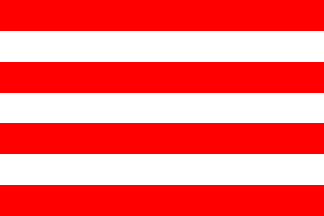
image
by Antonio Martins, 28 February 2001
This flag appears at Dr. Széll Sándor: Városaink neve,
címere és lobogója (1941) as "Székesfehérvár,
Fejér Co.".
István Molnár, 20 October 2000
Seven red and white horizontal stripes.
Antonio Martins, 28 Febuary 2001
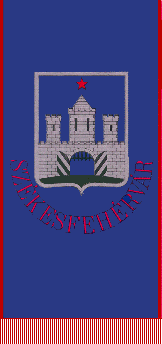
image
by István Molnár, 12 February 2001
This is the flags was used by Székesfehérvár Town
1974-1989. It seems the settlement tried to save its original
symbols. The CoA related to the original CoA, the colours of the
flag related the original colours.
István Molnár, 12 February 2001
fe-sf.gif)
image
by István Molnár, 9 February 2001
1)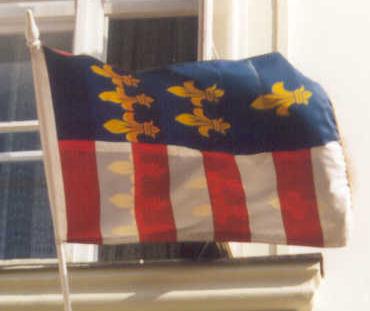
image
by István Molnár, 30 April 2002
Flag relates to the Anjou Dinasty flying on the City Hall of
Székesfehérvár. See: Hungary -
Historical Flags - Kingdom of Hungary (Pre-1848).
István Molnár, 30 April 2002
2)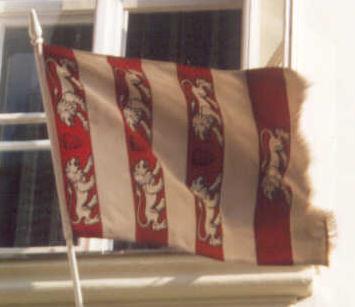
image
by István Molnár, 30 April 2002
Flag relates to the Arpad Dinasty flying on the City Hall of
Székesfehérvár. See: Hungary -
Historical Flags - Kingdom of Hungary (Pre-1848).
István Molnár, 30 April 2002